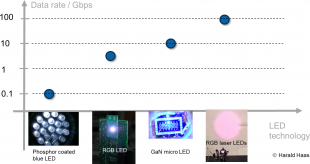Recent news report that LiFi is 100 times faster than WiFi. The assumption was that the average WiFi speeds are 10 Mbps, and that LiFi can be as fast as 1 Gbps. In this discussion, it is important to compare like-for-like, and it must be stressed that 1 Gbps from an off-the-shelf LED have not been demonstrated. The facts are:
- The visible light spectrum is 1,000 times larger than the entire 300 GHz of radio, micro wave and mm wave radio spectrum, so there is a big untapped reservoir of resources for wireless systems.
- Phosophor coated white LEDs which are mostly used in all commercial lighting devices can deliver up to about 100 Mbps.
- Red, Green, Blue (RGB) LEDs can deliver up to about 5 Gbps.
- Laser based white LEDs with a diffuser to create a broad light beam could transmit up to 100 Gbps (http://bit.ly/1TdI7Yg and http://bit.ly/1AgcwAJ).
- The fastest WiFi in the 60 GHz frequeny band, WiGig, can achieve a maximum data rate of 7 Gbps.
- The experienced data rate in a network where multiple users must share the bandwidth is significantly lower than the maximum headline number for data rates in WiFi systems.
- Therefore, a more important metric is the data rate per square meter, or area data rate.
- The area data rate of a LiFi network compared can be 1,000 times higher than the area data rate of a WiFi network. The main reason for this is that while there can only one WiFi router in a room as interference would destroy the bandwidth, there can be tens and more light bulbs in a room as interference behaves entirely different when using light to carry data.


